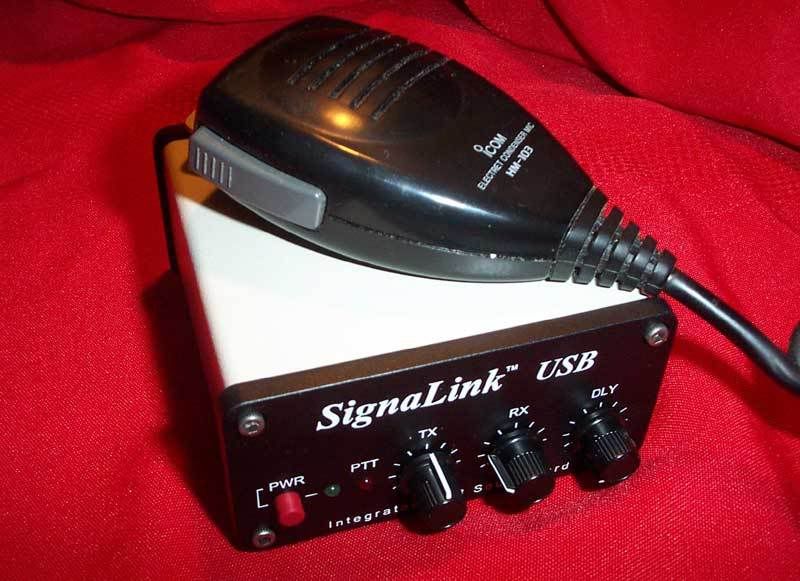It's been a while since I wrote here, but I'm back. For a time I even deactivated this journal, but I thought to myself, “Self, what the heck am I doing?” So I'm back — for what that's worth.
I do have something to report on, a new product that arrived in my shack recently, and its worth discussing.

The SignaLink USB is an digital sound card interface built by Tigertronics, the company that brought the BayPac modem and other digital hardware. Sound card interfaces are nothing new, but the SignaLink USB is unique — not only is it an interface, but it has its own high-quality sound card built in.
In other words, it doesn't matter what sound card you have in your PC or laptop — SignaLink USB processes it all in the interface. It was the perfect answer to my problem, and its got me on the air using a dizzying number of sound card digital modes.
I don't have room at the operating position for a desktop PC and monitor, and the laptops I have wont' support sound card modes (newer ones might, but neither of mine will work). The SignaLink USB was the perfect solution.
The interface only has two connections: The first is the USB cable from PC to interface (included). The second is the cable from interface to the rig.
On my Yaesu FT-2000, I had a couple of choices for how I wanted to setup the SignaLink. I could operate it from the microphone jack, or use the data connection in the back. I opted for the data connection on the rear panel, and glad I did.
Because the SignaLink USB works with any rig, you have to wonder how the heck they change handle so many different wiring possibilities from one rig to the next. The SignaLink uses jumpers that are put into an 16-pin IC socket on the interface's main PC board. It only takes 3 or 4 jumpers, and they simply connect the PTT, Data In, Data Out and ground to the interface. The jumpers are fine, but what if you want to use the SignaLink on more than one rig?
The company offers a programming header, which essentially is a plug that inserts into the jumper socket. The user has to wire the jumpers on the programming header, but once done, you can unplug the header and replace it with a header that is wired for another rig. It sounds convoluted, but it really isn't.
Wiring the programming header takes a magnifying glass (for me, it does anyway!) and some solid hook up wire. There's a cap that you can snap over the wiring to make it look neat, but the cap isn't necessary. I had short from the ground to the audio in, but that was my fault for not checking the finished soldering job more closely.
The SignaLink is small — about 3-1/4 x 3-5/8 inches. As you can see by the photo, its dwarfed by the Icom 706 microphone.
Because my FT-2000 sits on a shelf with other equipment, plugging in the cable with the 5-pin DIN connector without seeing what I was doing caused me a bit of anxiety. I didn't get the connector plugged in properly, so the interface didn't seem to work. However I could get it to work by letting the laptop pick up audio from my rig through the laptop's microphone. The interface worked fine, but there had to be cable issue, and it was. After plugging it the DIN plug in properly, I was cooking with gas!
I haven't tried every mode with it, but I have used AMTOR, RTTY, PSK31, CW and SSTV. The SignaLink is an incredible value. Once I got past my errors, it worked great!
I guess it has to do with my laptop, but everytime I unplug the USB cable, it reverts the laptop's sound card settings back to default, which I have to change when I want to fire up the SignaLink. This befuddled me the second time I tried to use it because I had unplugged ad reconnected the USB cable. My Dad used to say, “When all else fails, read the directions,” and sure enough, this issue is addressed in the FAQ.
There are only three controls on the front panel, and the only one you really ever adjust is the RX levels. The interface takes its power from the USB port, so there's no wall wart or other supply needed.
I'm looking forward to using the SignaLink and trying some new modes with it.
I purchased mine from DX Engineering. I also bought two cables and two programming headers. DX Engineering prices are a little cheaper than Tigertronics, and they had them in stock and shipped it quickly.
I'm sold on the SignaLink, though I'm considering a second one just so I can dedicate one of them to my home station. I can see how it would be neat to have one on the road running mobile. The programming header changes require the user to take the unit apart, and while that's not difficult, its a pain if you want to quickly switch it to another rig.
For the money ($99 with cables), its a value that's hard to beat.
